Class 9 - Mathematics
Linear Equations in Two Variables - Exercise 4.3
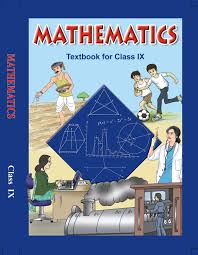
Top Block 1
Question : Draw the graph of each of the following linear equations in two variables:
(i) x + y = 4 (ii) x – y = 2 (iii) y = 3x (iv) 3 = 2x + y
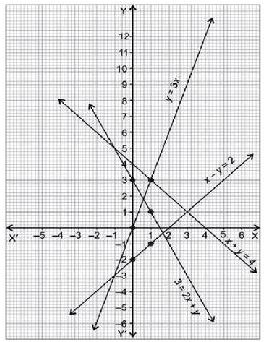
Answer :
(i) x + y = 4
For x = 0, y = 4
For x = 1, y = 2
So, we have points (0, 4) and (1, 3)
(ii) x – y = 2
For x = 0, y = -2
For x = 1, y = -1
So, we have points (0, -2) and (1, -1)
(iii) y = 3x
For x = 0, y = 0
For x = 1, y = 3
So, we have points (0, 0) and (1, 3)
(iv) 3 = 2x + y
For x = 0, y = 3
For x = 1, y = 1
So, we have points (0, 3) and (1, 1)
Question : 2: Give the equations of two lines passing through (2, 14). How many more such lines are there, and why?
Answer :
(2, 14) means x = 2 and y = 14
Following equations can have (2. 14) as the solution, i.e. they can pass through the point (2, 4).
(i) x + y = 16 (ii) 7x – y = 0
There can be an unlimited number of lines which can pass through the point (2, 14) because
an unlimited number of lines can pass through a point.
Question : 3: If the point (3, 4) lies on the graph of the equation 3y = ax + 7, find the value of a.
Answer :
Given, the point (3, 4) lies on the graph of the equation 3y = ax + 7
⇒ 3 * 4 = a * 3 + 7
⇒ 12 = 3a + 7
⇒ 3a = 12 – 7
⇒ 3a = 5
⇒ a = 5/3
So, the value of a is 5/3
Question : 4: The taxi fare in a city is as follows: For the first kilometre, the fare is Rs 8 and for the sub-sequent distance it is Rs 5 per km.
Taking the distance covered as x km and total fare as Rs y, write a linear equation for this information, and draw its graph.
Answer :
Total fare is calculated as
y = 1 * 8 + (x – 1)5, where x is in km and y is in Rs.
So, the required equation is:
y = 8 + 5x – 5
⇒ y = 5x + 3
Now, for x = 1
y = 5 * 1 + 3
⇒ y = 5 + 3
⇒ y = 8
For x = 2
y = 5 * 2 + 3
⇒ y = 10 + 3
⇒ y = 13
So, the points are (1, 8) and (2, 13).
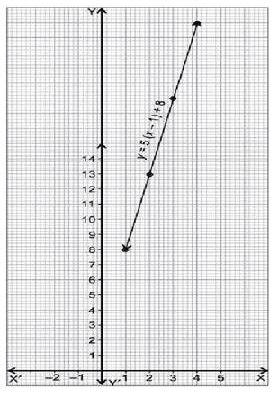
Mddle block 1
Question : 5: From the choices given below, choose the equation whose graphs are given in Fig. 4.6 and Fig. 4.7.
For Fig. 4. 6 For Fig. 4.7
(i) y = x (ii) x + y = 0 (i) y = x + 2 (ii) y = x – 2
(iii) y = 2x (iv) 2 + 3y = 7x (iii) y = –x + 2 (iv) x + 2y = 6

Answer :
For Fig. (i), the correct linear equation is x + y = 0
[Since (–1, 1) ⇒ -1 + 1 = 0 and (1, –1) = 1 + (–1) = 0]
For Fig. (ii), the correct linear equation is y = –x + 2
[Since (-1, 3) ⇒ 3 = -(-1) + 2 ⇒ 3 = 3 and (0, 2) 2 = -(0) + 2 ⇒ 2 = 2]
Question : 6: If the work done by a body on application of a constant force is directly proportional to the distance travelled by the body,
express this in the form of an equation in two variables and draw the graph of the same by taking the constant force as 5 units.
Also read from the graph the work done when the distance travelled by the body is:
(i) 2 units (ii) 0 unit
Answer :
Let y = work done
F = constant force = 5
x = distance travelled
Then y = 5x
For x = 0, y = 0, For x = 1, y = 5, For x = 2, y = 10
For x = 3, y = 15, For x = 4, y = 20
(i) Let A represent x = 2. The x-axis. From A, draw AB Ʇ x-axis,
Meeting the graph at B. From B, draw BC Ʇ y-axis, meeting y-axis
at C. The ordinate of C is 10.
So, when the distance travelled is 24 units, the work is done.
(ii) For x = 0, y = 0, the graph is shown above.
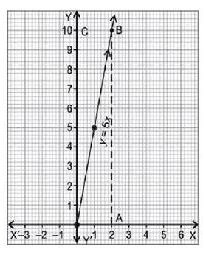
Question : 7: Yamini and Fatima, two students of Class IX of a school, together contributed Rs 100 towards the Prime Minister’s Relief Fund to help the earthquake victims.
Write a linear equation which satisfies this data. (You may take their contributions as Rs x and Rs y.)
Draw the graph of the same.
Answer :
Let Yamini contributes X rupees and Fatima contributes Y rupees.
Then according to question,
X + Y =100 ………..1
Put value of X = 0 in equation 1, we get
y = 100
Put value of X = 50 in equation 1, we get
50 + Y = 100
⇒ Y = 100 – 50
⇒ y = 50
Put value of X = 100 in equation 1, we get
100 + Y = 100
⇒ Y = 100 – 100
⇒ y = 0
So different solution of the equation 1 is:
X : 0 50 100
Y: 100 50 0
The graph is shown above.
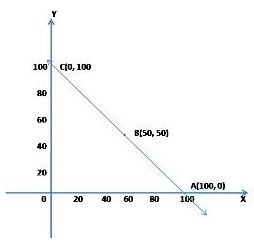
Question : 8: In countries like USA and Canada, temperature is measured in Fahrenheit, whereas in countries like India, it is measured in Celsius.
Here is a linear equation that converts Fahrenheit to Celsius:
F = (9/5)C + 32
(i) Draw the graph of the linear equation above using Celsius for x-axis and Fahrenheit for y-axis.
(ii) If the temperature is 300C, what is the temperature in Fahrenheit?
(iii) If the temperature is 950F, what is the temperature in Celsius?
(iv) If the temperature is 00C, what is the temperature in Fahrenheit and if the temperature is 00F, what is the temperature in Celsius?
(v) Is there a temperature which is numerically the same in both Fahrenheit and Celsius? If yes, find it.
Answer :
Given equation is
F = (9/5)C + 32 ………………..1

(i) We have to take Celsius for x-axis and Fahrenheit for y-axis.
Now put C = 0 in equation 1, we get
F = (9/5)*0 + 32
⇒ F = 32
Again put C = 5 in equation 1, we get
F = (9/5)*5 + 32
⇒ F = 9 + 32
⇒ F = 41
Again put C = -5 in equation 1, we get
F = (9/5)*(-5) + 32
⇒ F = -9 + 32
⇒ F = 23
So
C: 0 5 -5
F: 32 41 23
(ii) When C = 300, the from equation 1
F = (9/5)*30 + 32
⇒ F = 9*6 + 32
⇒ F = 54 + 32
⇒ F = 86
(iii) When F = 950, the from equation 1
95 = (9/5)*C + 32
⇒ (9/5)*C = 95 – 32
⇒ (9/5)*C = 63
⇒ C = (63*5)/9
⇒ C = 7*5
⇒ C = 35
(iv) When C = 00, the from equation 1
F = (9/5)*0 + 32
⇒ F = 32
When F = 0, the from equation 1
0 = (9/5)*C + 32
⇒ (9/5)*C = – 32
⇒ C = (-32*5)/9
⇒ C = – 160/9
⇒ C = – 17.8
(v )Let X degree of celsius = X degree of Fahrenheit, then from equation 1, we get
X = (9/5)*X + 32
⇒ X – 32 = (9/5)*X
⇒ 5(X – 32) = 9X
⇒ 5X – 160 = 9X
⇒ 9X – 5X = -160
⇒ 4X = -160
⇒ X = -160/4
⇒ X = -40
So, at X = -40, both Celsius and Fahrenheit are same.
